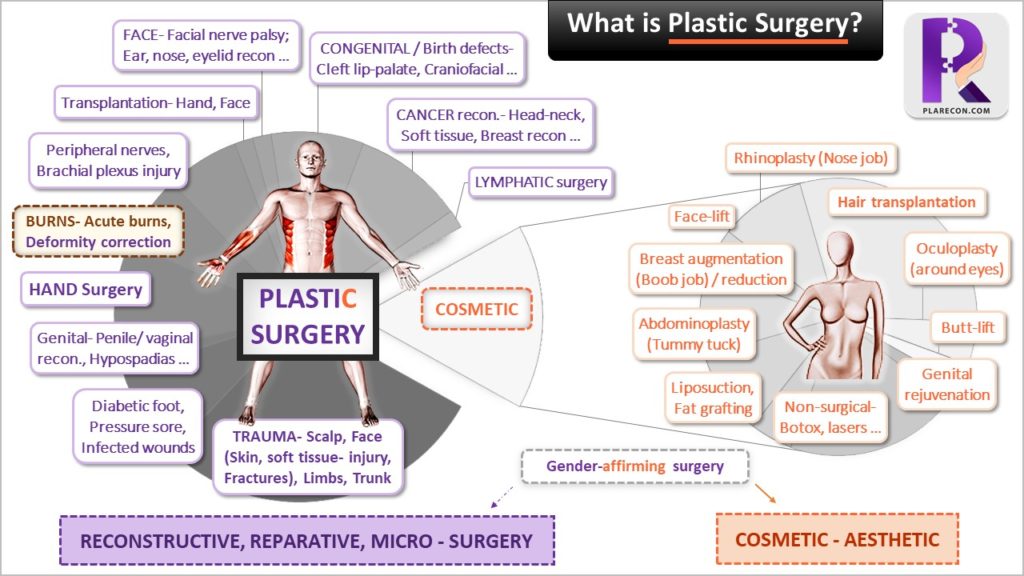Plastic Surgery is a poorly understood speciality amongst not just the general public but also medical students and medical professionals from other disciplines. In today’s times where most limb crush injuries may be reconstructed and need not amputated (one example) if standard care is to be provided to the patients, no institute or trauma centre (and even the smaller multispecialty or super-speciality clinics) can function without a team of Plastic surgeons.
Unfortunately, that’s not the case in India and still ‘avoidable amputations’ prevail in many places. Forget about a team, most hospitals don’t even have a single in-house Plastic surgeon. Even when some of the bigger hospitals finally look out for Plastic Surgeons- they will mention: Cosmetic surgeon needed!
Following are some of the possible reasons why Plastic Surgery is marred by misconceptions and hence the neglect and educating the general public, other doctors, and in turn the healthcare sector; and some possible solutions.
1. It’s Not All in the Name!
The term ‘plastic surgery’ originated from the Greek word ‘plastikos‘, meaning ‘to mould’ or ‘to transform’. Technically, the term actually does describe this diverse discipline really well, since it’s all about restoring form and/or function and eventually transforming (quality of) life.
However, for most (non-Greek), ‘plastic’ means a polymeric material that has the capability of being moulded or shaped by the application of heat and pressure (a term derived from the same Greek word- ‘plastikos’). 😊
It gives absolutely no information about the discipline but instead adds confusion→ “An endoscopic surgeon uses an endoscope. So, maybe these doctors use ‘plastic’ to make us look better!!“
Giving more descriptive names starting with ‘Plastic’ to our departments– like Dept. of Plastic, Hand and Reconstructive Microsurgery; Dept. of Plastic, Reconstructive, Aesthetic Surgery and Burns [based on the active sub-specialities] and also dividing large departments into several overlapping ‘units’– like Unit of Head, Neck and Breast Reconstructive Oncoplastic surgery; Unit of Cleft and Craniofacial Surgery; Unit of Lymphatic Surgery; Unit of Lower limb reconstruction and Diabetic Foot management; etc.— gives a clearer idea to other physicians and patients about the department.
2. Not relatable to anything particular
Plastic surgery is not restricted to a particular age (pediatric surgery), sex (gynaecology), a region of the body (ENT, thoracic surgery), organ system (urology, gastro-surgery), or a disease (onco-surgery).
It’s truly a very broad speciality in terms of the number of aspects of medical and surgical management it touches, unified only by common guiding principles and skill-sets. Hence, let’s accept it, it’s quite difficult for anyone to visualize plastic surgery in its entirety. Here’s an attempt to put most of it in a single page:
3. Relatively new, rapidly evolving discipline
- The seeds of Modern Plastic surgery were sown in the 1920s out of the need for reconstruction of devastating injuries during World War I, with the efforts of Harold Gillies (considered the father of modern plastic surgery);
- Reconstructive microsurgery arrived in the 1960s when free flaps and replantations started off. It gained popularity after the perforator concept came to the forefront in the 1990s;
- Burns management in a way got revolutionized only in the 1960s when Zora Janžekovič introduced her method of early tangential removal of dead burnt skin and covering it with skin grafts;
- Modern Aesthetic / Cosmetic surgery started taking shape in the 1960s and 1970s when newly created silicone was growing in popularity.
- Brachial plexus and peripheral nerve reconstruction evolved into a sub-speciality after Oberlin’s landmark paper on nerve transfer to biceps. in 1994;
- The era of hand transplantation began in the late 1990s and full-face transplantation in 2010s (last decade);
- Lymphatic surgery using supermicrosurgery techniques has evolved rapidly recently (last couple of years).
Historically, Plastic Surgery is one of the first surgical specialities in India and the world with the Nasal reconstruction using cheek flap being described by Maharshi Sushruta in Sushruta Samhita way back around 800-1000 B.C. However, the first department of Plastic Surgery was established in India in 1950 and surgical training in Plastic surgery was initiated in 1960.
Moreover, it’s major components, i.e. Reconstructive microsurgery, Burns and Aesthetic surgery gradually gained popularity over the last 4-5 decades in India. That’s the reason, many experienced elderly clinicians may still not be exposed to the nuances of this discipline so as to direct needy patients and intra-departmental meetings with disciplines like orthopaedics, ENT, neurology, endocrinology, nephrology may be helpful.
4. Not always in the front-line
Many a time, the patient gets admitted under a surgeon from another department, who either fixes the fractured bone or excise the tumor in head and neck or other parts of the body and we, the plastic surgeons are called in the theatre to cover the composite and often complex soft tissue +/- bony defects. Then, the patient was followed up post-operatively primarily by the admitting surgeon and if there is no flap related complication, the patient may not even know the name of the Plastic Surgeon involved.
It’s a different story that the Plastic surgical reconstruction may involve much more complexity, skill and take the major bulk of the total surgical time. Many a time, the fracture fixation can be useful only if the reconstruction and limb salvage is possible; the tumor excision possible only if the defect can be reconstructed.
Logically, this should not be encouraged strictly. Even in emergency cases, unless it’s an intra-operative emergency, only if all Plastic surgeons make it point to counsel the patient’s side pre-operatively about the Plastic surgical procedural details, possible outcomes and complications themselves, and follow-up closely postoperatively, this issue be possibly resolved.
5. Not indispensable… yet!
Today, by active Plastic surgical intervention, a cut or crushed finger or hand may be salvaged, reconstructed and made functional. Similarly, major burn patients may be saved by early excision and cover (examples)— but as long as the hospital administrators and the public, in general, are not aware of these possibilities and ask for them- these cases may never reach a Plastic Surgeon in the first place, and in time.
So, though plastic surgical interventions in such cases are not yet considered indispensable in India, with ignorance prevailing at various levels- the standard of care provided ultimately will remain low, and amputations of salvageable fingers or hands may be considered the best possible option (knowingly or unknowingly). National Plastic Surgery Day and other efforts, esp. online (more under point 7 below) to create awareness- is a possible way out.
6. Celeb News, TV Series hypes Sell
Stories (speculative most of the time) of cosmetic surgeries undergone by actors are often hyped and shown in mainstream media- possibly as they sell well. These, along with television series like House M.D., Nip/Tuck, Botched etc. depicting cosmetic surgeons and unreaalistic facial transformations depicted in some movies like Face/Off, Stolen Face- play a major role in creating the greatest misconception of all: All plastic surgeons are cosmetic surgeons who can be afforded only by the richest.
The reach and influence of such movies and television shows are difficult to beat it. The lives of most of the pioneers in Plastic Surgery and the feats they have achieved are such that if correctly depicted through movies, they will be nothing short of a thriller. May be short films, to begin with, and eventually, mainstream movies (like ‘The man who knew infinity’ for Ramanujam) would be the ultimate way to create awareness.
7. Misleading Google Search Trends
Dr. Google or other search engines don’t come in handy when someone searches for a term- ‘Plastic Surgery’ and instead bombards them with links to all sorts of graphic images related to spicy news of cosmetic surgeries (overt/unrealistic or botched up) and sometimes even por**graphic websites.

If we look into it analytically- Is Google responsible for this? Google is just presenting to the user the most appropriate related contents that are available online.
So, who should be creating these more authentic, realistic Plastic Surgery online content (posts, images, videos, social media stories)? We, the Plastic Surgeons, are probably the best people to come up with ways to increase the volume of authentic information related to the entire spectrum of Plastic Surgery that is available online so that the patients are not led to misinformation and unnecessary information from abstracts or journals.
In the last decade, there has been a positive shift in this aspect with several national and international Plastic Surgery associations and individuals are making conscious efforts towards creating more educational and informative contents and making them available online for the benefit of students and other information seekers. The COVID pandemic slowdown also played a positive role in boosting this last year.
Below, is an informative video highlighting a few aspects of Plastic Surgery, posted by the Department of Plastic Surgery, University of Pittsburgh way back on 20 Aug 2012.
8. Greater online presence of Cosmetic surgery
The nature of Cosmetic / Aesthetic Surgery, where privacy of patients plays an important role, makes many patients prefer not-so-crowded private clinics. For such private clinics, good web and social media presence in order to become visible initially is a necessity. Moreover, the term Cosmetic surgery is used by many disciplines other than Plastic surgery worldwide- liked some dermatologists.
This has led to a disproportionately high web and social media content related to cosmetic surgery such that if any layperson tries to figure out what exactly plastic surgery is? – they will be convinced that it’s all cosmetic surgery- though, in reality, it forms only a small fraction of the entire Plastic surgery spectrum.
Other than making conscious efforts to increase the content from other aspects of Plastic surgery, what other option do we have to we have, or is it irreparable?
If you are a Plastic Surgeon, do you agree with the 8 points above? Am sure you have other reasons in mind too. We will really appreciate if you share your views in the ‘comments’ section below.
If you found this post useful subscribe below for more such articles & subscribe to our YouTube channel for video tutorials. You can also find us on Facebook, Twitter and Instagram.
References (for further reading):
- C.S. Dunkin, J.M. Pleat, S.A. Jones, T.E. Goodacre. Perception and reality-a study of public and professional perceptions of plastic surgery. Br J Plast Surg, 56 (2003), pp. 437-443.
- Fang F, Chung KC. An evolutionary perspective on the history of flap reconstruction in the upper extremity. Hand Clin. 2014;30(2):109-v.

Tutorials & tips in Plastic Surgery
+ Weekly updates of high-quality webinars!





VERY NICE ARTICLES
Glad you liked them!
Excellent. How can we share them to create more awareness in public
Thank you!
The social share buttons are now showing at the bottom of the post. Please do share!
As an a newly graduated surgeon based in in Africa, this is the best information I can get to shape the perspectives of others around me !! And thank you for taking the effort!!